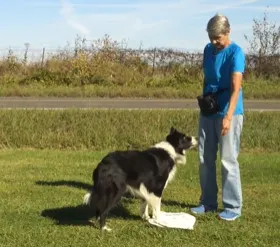PHD Blog 24 - TRaC Training
Sneak Peek
Get your herding training on TRaC
From Positive Herding 101
Most asked question
The question I am asked most frequently is, "How do I start training herding using positive methods?" The answer is, start just as you would training your dog to be a good companion, with sit, down, recall, and loose leash walking.
Your dog already knows these behaviors? Then ask your dog to do them while you quickly move a tug or hold a favorite treat just inches away from your dog's nose. Do they still respond quickly and accurately? How about when a flirt pole toy is running away from them? Still good? Then it is time to take these behaviors near penned livestock.
What does this have to do with herding?
Behavior is behavior. If your dog cannot sit when asked near livestock, they will not be able to take herding cues such as come bye, away to me, walk in, or recall off of stock. If you want to give your dog a head start on herding, give them a solid foundation of basic skills.
Which brings us to the TRaC skills
TRaC skills, timing, rate of reinforcement, and criteria, are the mechanical skills that provide a framework for your training. Let's jump into Positive Herding 101 for a closer look.
Getting on TRaC
The more clearly we communicate with our dogs, the easier it is for them to develop the precise behaviors we need for herding. To tell my dog what gains reinforcement and what does not, I rely on timing, rate of reinforcement, and criteria. (Bailey and Farhoody 2013-2015) I also use no reward markers and time outs, negative punishment, to decrease self-reinforcing instinctual behavior, such as chasing livestock.
I call these important training tools the TRaC skills. TRaC skills include timing, rate of reinforcement, and criteria. When I use these skills wisely my dog should make few mistakes because my communication is crystal clear. But my dog is going to make mistakes and certainly some of these mistakes will be due to my less than stellar use of timing, rate of reinforcement, and criteria. If I trained perfectly then my dog would respond correctly almost 100% of the time. Figure those odds!
Since mistakes are going to happen. I can choose to ignore them in most instances and allow extinction to eventually eliminate the unwanted behavior. So why not just do that? The reason I use no reward markers is that many of the herding skills, such as flanking and walking in to stock, are self-reinforcing for herding dogs. I also use time outs for big infractions such as chasing, lunging at, or flagrant biting of stock. Since time outs are similar to no reward markers, I will discuss them in this chapter.
Before we worry about telling our dogs that they are not heading towards reinforcement with a no reward marker or time out, we need to hone our TRaC skills and become very good at telling our dogs what does earn reinforcement.
Timing, rate of reinforcement, and criteria are critical to good training but they will do you no good if you don’t have a clear idea of the behavior you are training. Before you begin a training session you need to define the behavior you want to train. If you can define your goal behavior in one simple sentence, you are good to go.
Let's take a quick look at Sally starting to train an 8 week old border collie to herd. Yes, herd! All advanced training starts with fundamentals. The clip is too short to see the rate of reinforcement being used but I am sure it is quite high in order to keep the puppy engaged.
You will be able to see her timing and use of criteria. Sally asks for several behaviors and also shakes the tug while asking the pup to hold the sit, which is classic positive herding training - perform a behavior while being distracted by movement.
Can you see how Sally is already putting positive herding components into the training?
If you found this blog interesting, please tell your friends and spread the herd!
Barb
Come bye to learn more about herding!
Join my list to receive the latest news and updates.
(Don't worry, your information will not be shared.)

